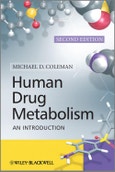The book focuses on giving the reader a conceptual understanding of the drug metabolism system, illustrating basic mechanisms of how xenobiotics are detected, chemically modified and then eliminated from human systems.
- A concise, accessible and engaging introduction to drug metabolism
- Avoids unnecessary technical and chemical detail
- Focuses on a conceptual understanding of the drug metabolism system
- Provides a wealth of examples to engage student interest and explore the clinical consequence of drug metabolism in simple terms
Reviews of first edition:
"The author has certainly achieved his goal of providing an accessible introduction to human drug metabolism" The Annals of Pharmacotherapy, June 2006
"Armed with the knowledge contained in this book, we should all be well on the way" Pharmaceutical Physician, May 2006
" a useful introductory text for the intended audience of students studying pharmacology and toxicology " Veterinary Pathology, November 2006
Table of Contents
Preface.Preface to First Edition.
1. Introduction.
1.1 Therapeutic window.
1.2 Consequences of drug concentration changes.
1.3 Clearance.
1.4 Hepatic extraction and intrinsic clearance.
1.5 First pass and plasma drug levels.
1.6 Drug and xenobiotic metabolism.
2. Drug Biotransformational Systems Origins and Aims.
2.1 Biotransforming enzymes.
2.2 Threat of lipophilic hydrocarbons.
2.3 Cell communication.
2.4 Potential food toxins.
2.5 Sites of biotransforming enzymes.
2.6 Biotransformation and xenobiotic cell entry.
3. How Oxidative Systems Metabolize Substrates.
3.1 Introduction.
3.2 Capture of lipophilic molecules.
3.3 Cytochrome P450s classification and basic structure.
3.4 CYPs main and associated structures.
3.5 Human CYP families and their regulation.
3.6 Main human CYP families.
3.7 Cytochrome P450 catalytic cycle.
3.8 Flavin monooxygenases (FMOs).
3.9 How CYP isoforms operate in vivo.
3.10 Aromatic ring hydroxylation.
3.11 Alkyl oxidations.
3.12 Rearrangement reactions.
3.13 Other oxidation processes.
3.14 Control of CYP metabolic function.
4. Induction of Cytochrome P450 Systems.
4.1 Introduction.
4.2 Causes of accelerated clearance.
4.3 Enzyme induction.
4.4 Mechanisms of enzyme induction.
4.5 Induction general clinical aspects.
5. Cytochome P450 Inhibition.
5.1 Introduction.
5.2 Inhibition of metabolism general aspects.
5.3 Mechanisms of inhibition.
5.4 Cell transport systems and inhibition.
5.5 Major clinical consequences of inhibition of drug clearance.
5.6 Use of inhibitors for positive clinical intervention.
5.7 Summary.
6. Conjugation and Transport Processes.
6.1 Introduction.
6.2 Glucuronidation.
6.3 Sulphonation.
6.4 The GSH system.
6.5 Glutahione S–transferases.
6.6 Epoxide hydrolases.
6.7 Acetylation.
6.8 Methylation.
6.9 Esterases/amidases.
6.10 Amino acid conjugation (glycine or glutamate).
6.11 Phase III transport processes.
6.12 Biotransformation–integration of processes.
7. Factors Affecting Drug Metabolism.
7.1 Introduction.
7.2 Genetic polymorphisms.
7.3 Effects of age on drug metabolism.
7.4 Effects of diet on drug metabolism.
7.5 Gender effects.
7.6 Smoking.
7.7 Effects of ethanol on drug metabolism.
7.8 Artificial livers.
7.9 Effects of diseases on drug metabolism.
9.10 Summary.
8. Role of Metabolism in Drug Toxicity.
8.1 Adverse drug reactions: definitions.
8.2 Reversible drug adverse effects: Type A.
8.3 Irreversible drug toxicity: Type B.
8.4 Type B1 necrotic reactions.
8.5 Type B2 reactions: immunotoxicity.
8.6 Type B3 reactions: role of metabolism in cancer.
8.7 Summary of biotransformational toxicity.
Appendix A: Methods in Drug Metabolism.
A.1 Introduction.
A.2 Analytical techniques.
A.3 Human liver microsomes.
A.4 Human hepatocytes.
A.5 Human cell lines.
A.6 Heterologous recombinant systems.
A.7 Animal model developments in drug metabolism.
A.8 Toxicological metabolism–based assays.
A.9 In silico studies.
A.10 Summary.
Appendix B. Metabolism of Major Illicit Drugs.
B.1 Introduction.
B.2 Opiates.
B.3 Cocaine.
B.4 Hallucinogens.
B.5 Amphetamines.
B.6 Cannabis.
B.7 Dissociative anaesthetics.
Appendix C. Examination Techniques.
C.1 Introduction.
C.2 A first–class answer.
C.3 Preparation.
C.4 The day of reckoning.
Appendix D. Summary of Major CYP Isoforms and their Substates, Inhibitors and Inducers.
Suggested Further Reading.
Index.








